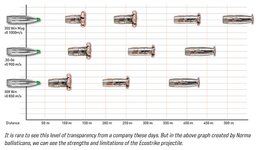I believe that the search for data to help to pick any bullet (lead or non-lead) is a valuable thing and that it should have some base-line metrics and standards to help make the data more defensible and to create consistent, reliable and accurate results.
There appear to be two ways to test for and analyze the performance of a bullet. The first is in lab testing by shooting bullets into gel. The second is field testing by actually shooting animals.
For the "lab testing" it is important to have a standardized protocol and methodology in place for obvious reasons. Because of that, I am of the opinion that the You-Tube testers shooting into clear gel should be taken as entertainment and not as reliable data. Hence my earlier post wishing out loud for an independent testing lab that could do this for real. As you will see below, I've found a few that exist and I intend to contact them to ask them how much it would cost to test a single bullet and/or a series of bullets and to discuss possible testing protocol.
For the lab testing there is a protocol already in place created by the FBI. Form talks about this a lot in his fantastically informative podcasts with the Exo Mountain Gear guys.
https://exomtngear.com/blogs/podcast/469
Here is an actual ballistic testing lab describing the FBI protocal for law enforcement bullet testing.
And here is a similar description from Hornady's law enforcement web site.
FBI Test Protocol Bullet Velocity All trajectories and associated velocities are from SAAMI minimum specification test barrels. An Oehler 83 model 35 P with model 55 skyscreens was used for velocity measurements. Bullet velocity was measured...

www.hornadyle.com
The standard testing protocol as described above was designed for testing bullets that were to be used in human conflict situations, so I don't think it is the ideal protocol for testing hunting. As I proposed in an early post, I'd suggest that every bullet be testing at varying impact velocities. (perhaps 3000, 2600, 2200, 1800, 1400fps) Furthermore, rather than testing the bullet through various "barriers" such as auto glass and drywall, I'd propose that the hunting bullet standard test includes a single simulant that represents hide and scapula. Some penetrative testing would need to be performed to come up with a good generic simulant, but I'm thinking of something like a single layer of astro turf spray-adhered to piece of 1/2" plywood be stuck to the front of the gel block to simulate hide and scapula in repeatable manner. It would be interesting to test a bullet on this and on just the plain gel block to see if there is any appreciable difference as maybe it doesn't make material difference and wouldn't need to be added.
As for the second way to collect data and test a bullet, this is the fun one. Field testing is being done and talked about on Rokslide every day! By it's nature it will not be as controlled as the lab testing would be. But if reliable data can be collected in big enough data sets I believe some trends and performance conclusions will become evident. Others with much more experience than me have said that over thousands of animals you can see a bullet's pros and cons pretty clearly. There is a study at Portland State that has just started which is trying to collect hunters terminal ballistic data and I can't wait to see their study results. They need lots of hunters to participate and enter their animal harvet terminal ballistic data. If you want to participate here is link to their data collection portal:
Information on species, cartridge, range, and animal behavior is very important to understand best practices for effectively and humanely harvesting wildlife. There is no consensus about "best practice" and increased knowledge will benefit both hunters and managers. Please enter all the...
portlandstate.qualtrics.com
I have personally started wading through the massive number of necropsy and kill reports on Rokslide and have started a spreadsheet database linked to each post. I can tell you from starting that work that many of these posts don't offer enough data to be helpful.
To be helpful most of the following items need to be detailed in your posts:
Bullet and grains
Animal and Sex
Shot Distance
Impact Velocity
Time to Incapacition
Distance Traveled Before Collapse
Impact Location
Did it Exit?
Meat Loss Factor (1-5)
Were their follow-up shots
If so, where did they impact.
I will keep working on collecting this data from existing postts on RS and wil share it with you all when i get more on paper.
DO

